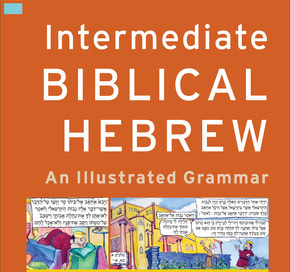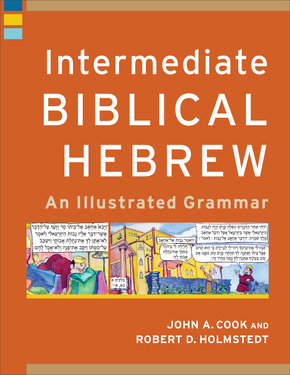Intermediate Biblical Hebrew
John A. Cook and Robert D. Holmstedt.
Intermediate Biblical Hebrew: An Illustrated Grammar.
Grand Rapids: Baker Academic, 2020.
Review by Dr. Jill Firth
Intermediate Biblical Hebrew: An Illustrated Grammar is designed to fill a gap in the range of resources available for studying Hebrew. There are many introductory textbooks whether of traditional grammar-translation approaches, or more recent communicative approaches. However, the authors argue that there are “startlingly few” textbooks for the intermediate stage of Hebrew study, where skills learned in an introductory course are applied, and learning is “embedded.”
Intermediate Biblical Hebrew builds on Cook and Holmstedt’s introductory textbook, Beginning Biblical Hebrew: A Grammar and Illustrated Reader (2013), which offered an immersive approach with grammatical teaching accompanied by visual storytelling in comic book form, plus aural-oral exercises designed to develop reading fluency. The Intermediate book is based on readings from the Elijah cycle (1 Kings 16:29 to 2 Kings 2:14). There are 24 readings, suitable for a 12-week semester with two classes per week. The authors propose that a further reference type textbook is not needed, but grammatical issues are discussed as they arise in the text, including semantics and syntax. Each reading is presented in cartoon form, with illustrations by Philip Williams. Vocabulary less than 200x is offered as required, along with invitations to go deeper with grammar, reading insights, and review questions. A feature of the book is beautiful facsimiles of selected pages of the Aleppo codex, which students read after being introduced to the text in about 9 chapters of the book, commencing in chapter 2. Cook and Holmstedt convincingly argue that students find great pleasure in the opportunity to read from ancient handwritten manuscripts.
A goal of the intermediate book is to promote reading fluency. Students are encouraged to read the texts aloud in class, memorise small sections of the text, present dramas based on the text, and to engage in comprehension exercises in English and Hebrew. Students also engage in writing exercises to develop familiarity with the language. The book includes an appendix on weak verb paradigms, and another on Masoretic accents, as well as a Hebrew-English Glossary. Online resources include flashcards, audio files of exercises, vocabulary, and readings. Teachers can request sample quizzes and exams, lesson plans, and an instructor’s manual.
The authors write that “the most seamless transition will occur when moving from our BBH to the present volume.” This is true, particularly due to the linguistic approach of the authors, who use some less traditional grammatical terms such “enclitic pronouns” (traditionally called suffixed pronouns) and “proclitic preposition” (traditionally known as an inseparable preposition), as well as naming some grammatical terms in Hebrew. Additional terms occur in the chapters, such as “bound,” “supported,” “cliticization,” “null constituent,” and “overt constituent” (all found in the first lesson). Students coming from Cook and Holmstedt’s BBH will have become familiar with their metalanguage, but it will be an additional layer of learning for students whose introductory textbook used other approaches and linguistic terms. Many of these terms are explained in the Linguistics Glossary in the back of the book, but some terms and perhaps a framework for Cook and Holmstedt’s linguistic approach will require explanation by the lecturer.
This book is an excellent approach to the text, presenting cutting-edge teaching methods and linguistics. Alongside classroom use, Intermediate Biblical Hebrew: An Illustrated Grammar would make an enjoyable text for self-study, for a student who wishes to build on their first year of Hebrew learning.
Dr. Jill Firth is Lecturer in Hebrew and Old Testament at Ridley College in Melbourne, Australia.




